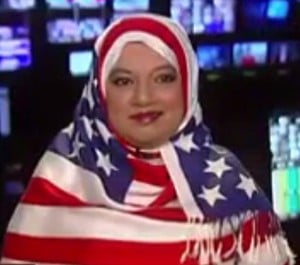Have you ever dreamed of being a hijabi in couture, strutting the runway in the fashion metropolises of Milan, New York or Paris without having to unravel that scarf you hold dear? Well, maybe you haven’t, but if you have, you’re in luck: thanks to Muslim fashion designer, Nailah Lymus, your dream may be in reach.

In November, Eren wrote a great piece on Muslim and Arab women breaking onto the fashion scene, and discussed Lymus’ commitment to changing the industry. UNDERWRAPS is the first modeling agency within the mainstream fashion industry that is specifically for Muslim models. However, it is important to note, that this agency is not the only avenue that has given opportunity to models of the Islamic world. Its founder, Lymus, 28, is a clothing and accessory designer who is committed to “using her God given talent to accentuate the the natural allure of the woman.” Dressed in eclectic patterns and textures, intricately tied scarves and bold blazers, Lymus has managed to combine fashion and modesty in an industry that consistently stresses that the more the eye can see, the more beautiful one will be. A single mother, who made her debut in New York Fashion Week in 2011, and has her own accessory line Amirah Creations, believes that there is no reason that individuals who want to wear hijab should have to compromise their values to work within the industry.
“[Muslim models] come from a background where they dress Islamically appropriate, but to be in this industry and to be a model you kind of have to forfeit that,” says Lymus. “That’s why I wanted to start this agency, so you don’t have to do that. You don’t have to lose who you are to be in this business.”
Personally, I am interested to see what UNDERWRAPS will bring to the industry. In a society that is constantly fed that light/white skin, and tall and thin features, are synonymous with universal ideals of beauty, Lymus’ agency can open a space where these conceptions can be challenged. I hope that Lymus, as a woman of colour, will diversify the colour palette to the models that she signs.
There is no question that UNDERWRAPS will lure in an already-established demographic. According to the U.K-based Daily Mail, Lymus may already appeal to an audience who would be sure to buy into her brand: Emirati and Saudi women who, it’s presumed, are secret Coco Chanel, Gucci-wearing fashionistas who hide behind their abayas. However, there is a danger in assuming that women in the Middle East will be the first to jump on board and advance into the fashion industry. Currently, Lymus has signed two models who are becoming successful within the industry:Tunisian, Hanna Ben Abdesslem and Moroccan model Hindi Sahlial. Both are Arab and neither wears the scarf. What I am interested to see is whether UNDERWRAPS will become trapped in the “light is best, white features are better” mentality that penetrates in other aspects of society, and will have difficulty in opening windows of opportunity for women who wish to keep their hair hidden. As a Muslim modeling agency, will it reflect the Muslim community in all its cultures and ethnicities, including African-American, Asian, South-Asian and other backgrounds?

One cannot talk about UNDERWRAPS without talking about the hijab. Will the agency contribute to dispelling the myth that women who wear the scarf are oppressed and are denied any sense of individuality? Or will the inclusion of hijabi fashion in New York Fashion week for example lead to the trivialization of the meaning behind wearing the hijab? The editor of the Muslim fashion blog Hijab Style, Jana Kossaibati, believes so. “I don’t think the way forward is simply to create the hijab-clad version of Claudia Schiffer. That reduces Islamic beliefs to the superficial.” This critique raises a question: can a balance be made between avoiding the capitalization of religious clothing norms and changing the discourse surrounding the controversies of hijab? I believe it will depend on who is represented, and how they are to be incorporated into the industry. Not to mention that simply having a modeling agency may not ensure more accessibility in magazines, shows and the runway. Will Lymus and her agency crack under the pressure of an industry that demands a certain look in order to keep the agency in operation or, will they stick to their (glue) guns and work on principle?
Although these questions and critiques exist, Lymus brings to attention the increasing presence of “Islamic”-influenced looks within the fashion-industry, including the incorporation of hijabi-styled models on the covers of reputable magazines and runway shows attributed to fashion powerhouses such as Vogue UK. Perhaps UNDERWRAPS can be a tool for Muslim women reclaiming and owning the representation of what Muslim modesty is – whether it involves hijab, niqab, or neither one – instead of having it appropriated by non-Muslim designers who tend to exotify and juxtapose Islamic dress with images of sexual repression and Western concepts of liberation.
What are the hopes and aspirations that Lymus has for her agency? “I’m bringing Muslims to mainstream– covered is the new couture.”
What do you think? Will a Muslim fashion agency contribute to a better and more holistic perception of hijab? Or will it risk the adoption of religious modes of representation that can further be appropriated and worn without meaning?











